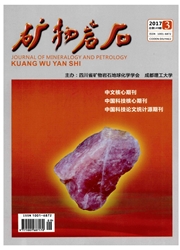

 中文摘要:
中文摘要:
华南是中国重要的钨、锡、铋、铜、银、锑、汞、稀有、重稀土、金和铅锌多金属重要成矿省,成矿时代以中-新生代为主。众多学者通过野外调查、构造变形解析、科学深钻、年代学研究等方法对华南各个区域进行构造地质学研究,并取得重要成果。但对整个华南中生代构造演化过程的认识依然存在分歧,这主要归咎于不同学者根据局部研究成果或单一地质要素对华南构造演化进行讨论。系统总结前人在华南研究的成果,对华南早燕山期古地层产出状态、古地理变化、古构造应力场、构造变形样式、岩浆记录等多种地质要素进行归纳。初步认为华南早燕山中晚期处于SEE-NWW或近EW向挤压构造背景下,时间界限大致为170~135 Ma,推测挤压事件可能是成矿大爆发开始的前奏,挤压作用将成矿物质预富集,形成矿化区域,为后期成矿作用提供物质基础及成矿有利空间。
 英文摘要:
英文摘要:
South China is one of the most important metallogenic provinces in China, which comprises plenty of W, Sn, Bi, Cu, Ag, Hg, Sb, REE, Au and Zn-Pb polymetallic ore, metallogenic epoch dominated by Mesozoic- Cenozoic. Many scholars research regional tectonics of South China through field surveys, analysis of tectonic deformation, scientific drilling, and methods of chronology, achieve important results. But there are still differences in the awareness of Mesozoic tectonic evolution of South China as a whole. This is mainly due to different scholars according to local research results or a single geological element on the tectonic evolution of South China was discussed. This study summarizing the research achievements in South China, concluding the state of the output of the ancient strata, Paleogeographic changes, ancient tectonic stress field, tectonic deformation style, lava records, and other geological factors in early yanshanian period, in South China. Initially considering the Mid-Late early yanshanian in South China under SEE-NWW or EW compressional tectonic background of time roughly 170 -135 Ma, speculating that compressional events may be the prelude to the beginning ore-forming eruption, compression will cause ore preconcentration, and the formation of mineralized area, providing material basis and favorable space for ore-forming in the late stage.
 同期刊论文项目
同期刊论文项目
 同项目期刊论文
同项目期刊论文
 期刊信息
期刊信息
